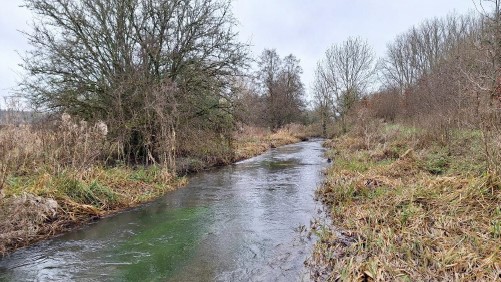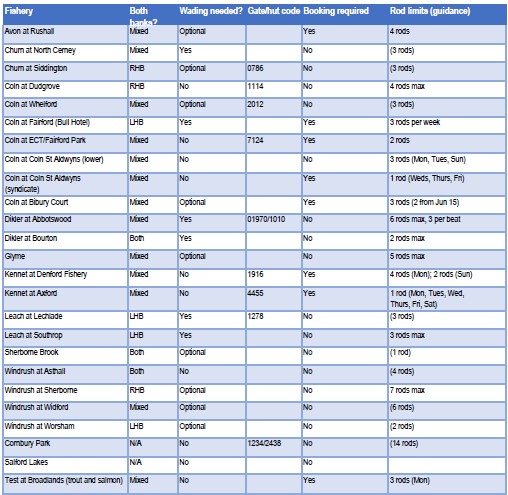introduction to our fishing
CFF fisheries
Coln at Coln St Aldwyns (lower)
Coln at Coln St Aldwyns (syndicate)
Note: all references to left or right hand bank are based on the convention that the true left bank is the left bank when looking downstream. Download a PDF of the Summary shown below here.
Quick link to the new bookings page
PDF summarising our fishing, days available, bookable status, wading, banks etc.
Link to the new 2023 fisheries summary and guide by Mark Purvis

Ampney Brook
The Ampney Brook is a small tributary of the Thames that rises just a couple of miles north-east of Cirencester and enters the Thames downstream of Cricklade.
It contained a large population of wild brown trout, some of which were of a surprisingly good size. The current status of the stock is not known, but five 'year cohorts' were rescued and returned to the Thames in 2022.
The water is generally clear and a stealthy approach is needed.
You will find it easier to fish with a short rod (7’6” max) and chest waders.
No guests allowed and all fish to be returned.

The River Avon, upper reaches - Rushall Beat, new for 2025. A bookable fishery with a limit of 4 rods per day, available for both wild brown trout and grayling fishing. To encourage use of this new water we have not limited your frequency of access on the bookings system: Quick link to the bookings system.
Season: 1st April to September 30th for trout, grayling June 16th to February 28th.

River Churn
The River Churn rises at Seven Springs, three or four miles south of Cheltenham, and is our most westerly trout fishing. It flows south-east passing through the villages of Colesbourne, Rendcomb and North Cerney before flowing through the middle of Cirencester. Below Cirencester it passes through Siddington, South Cerney and the Cotswold Water Park before joining the Thames at Cricklade.
The river generally runs clear being mostly fed by limestone runoff, although it does run across some areas of mudstone and sandstone. It has a good stock of wild trout throughout. There are a few coarse fish in the river lower down.
It has a good mayfly hatch. The Churn is a relatively small stream and the fish are not huge so a small brook rod of perhaps 7’6” at most and a light line (#2 to #4) would be the weaponry of choice. Waders can be useful in places.

River Coln
The River Coln is the best known of the Cotswold trout streams and we have access to six different stretches of the river, some of which are Bookable electronically .
The river rises above Andoversford on the Cotswold escarpment and flows through one of the most beautiful valleys in Gloucestershire. It passes through the tourists’ favourite Cotswold beauty spot Bibury and the smaller villages of Coln St Aldwyns and Quenington before reaching the market town of Fairford. From there it heads south-east, joining the Thames about a mile above Lechlade.
The water was historically gin clear and is still usually clear enough to stalk individual fish. It has relatively good fly life with early season hatches of LDOs and grannom and a good mayfly hatch.
Some of our fisheries on the Coln have supplementary stocking of trout but all contain wild trout of a good size and some grayling

River Dikler
The Dikler is a lovely spring-fed wild trout stream that rises above Donnington brewery before flowing through Upper and Lower Swell and eventually joining the Windrush just below Bourton-on-the-Water.
Fly life is excellent and this stream offers great dry fly fishing for beautifully marked and free-rising wild trout.

River Glyme
The Glyme is a tributary of the River Evenlode. It rises near Chipping Norton and is joined by the Heythrop Stream above Enstone and the River Dorn at Wootton (at the top end of our fishing). It then flows through water meadows into Woodstock where it feeds the ornamental lakes of Blenheim Palace. Below Blenheim the river flows into the River Evenlode near Bladon.
The Glyme is not particularly fast flowing but is renowned for its prolific mayfly hatch and while it is a small stream it has produced some specimen trout over the years.
River Leach
The River Leach is a small stream that rises above Northleach and enters the Thames at Lechlade. It is an interesting river, flowing almost entirely over limestone and disappearing underground for part of its course in the summer.
It runs very clear and has a tremendous stock of wild trout and good fly life. We have access to two stretches between Southrop and Lechlade.Again, this is small-stream fishing for spooky wild trout and a stealthy approach and light tackle are essential.

Sherborne Brook
The Sherborne Brook is a spring-fed tributary of the Windrush that has excellent water quality and rich insect life. It flows through water meadows on the National Trust’s Sherborne Estate and is blessed with wonderful wildlife. Do not drive beyond the first car park - risk of subsidence.
It is best fished by wading with a small rod and light tackle. Wild trout are plentiful and the club has been working on restoring the grayling population
River Windrush
The Windrush is one of the major Upper Thames tributaries, draining many of the Cotswolds’ most picturesque valleys. It rises in the limestone hills above Temple Guiting and flows south to Naunton and Bourton-on-the-Water where it is joined by the Dikler and its tributary the Eye before flowing on to Burford and then Witney. Downstream of Witney it splits into two channels before joining the Thames below Standlake.
We have four Windrush fisheries between Witney and Bourton, one of which receives some supplemental stocking of trout. All have wild trout and all offer prolific mayfly hatches. There are a few grayling and there is always a chance of a good-sized chub. Club members enjoy some coarse fishing on the lower Windrush during the winter months.

River Kennet
The Club has access to some premium chalk stream fishing on two estates between Kintbury and Marlborough. The Kennet has its source in chalk springs and flows due east through water meadows divided up by a maze of small carrier streams before joining the Thames at Newbury. The water is gin clear and fly life is excellent. Fish stocks include wild brown trout, including the unique Kennet greenback strain, grayling and supplemental stockings of brown and rainbow trout.

Cornbury Park Lakes
Cornbury Park lies in the Wychwood Forest, a medieval royal hunting ground between the Evenlode and Windrush valleys. The club has fishing rights on three lakes set in a secluded deer park setting. All three of the lakes are stocked with trout. The middle lake is also retained as a coarse fishery.
The lakes enjoy good fly hatches and fish well with dry flies and imitative patterns.


salford fishing lakes
Salford Trout Lakes offers fishing for rainbow, brown, tiger and sparctic trout in two scenic lakes in a secluded valley to the west of Chipping Norton.
Members must clearly log their name, the initials CFF and membership number in the hut fishing book before starting to fish and complete a catch return in the same book at the end of their session (use capitals please and sign in both books if both lakes are fished).
Day tickets may be purchased for guests as detailed on Salford web site (https://www.salfordtroutlakes.co.uk/). Members are limited to one visit per fortnight. Two fish may be killed per visit and members can continue to fish on a catch and return basis. CFF badges and car stickers must be displayed. Members must abide by the fishing rules posted in the hut and record their fishing returns including blank days. Fish taken at Salford lakes do not count towards the CFF catch limit.

broadlands estate river test
Trout and salmon fishing on the River Test .
Full details and rules will be supplied on completion of the booking form.
